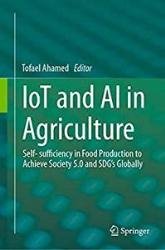 Название: IoT and AI in Agriculture: Self-sufficiency in Food Production to Achieve Society 5.0 and SDG's Globally
Название: IoT and AI in Agriculture: Self-sufficiency in Food Production to Achieve Society 5.0 and SDG's GloballyАвтор: Tofael Ahamed
Издательство: Springer
Год: 2023
Страниц: 469
Язык: английский
Формат: pdf (true)
Размер: 21.3 MB
This book reviews recent innovations in the smart agriculture space that use the Internet of Things (IoT) and sensing to deliver Artificial Intelligence (AI) solutionsto agricultural productivity in the agricultural production hubs. In this regard, South and Southeast Asia are one of the major agricultural hubs of the world, facing challenges of climate change and feeding the fast-growing population. To address such challenges, a transboundary approach along with AI and BIG data for bioinformatics are required to increase yield and minimize pre- and post-harvest losses in intangible climates to drive the sustainable development goal (SDG) for feeding a major part of the 9 billion population by 2050 (Society 5.0 SDG 1 & 2). Therefore, this book focuses on the solution through smart IoT and AI-based agriculture including pest infestation and minimizing agricultural inputs for in-house and fields production such as light, water, fertilizer and pesticides to ensure food security aligns with environmental sustainability. It provides a sound understanding for creating new knowledge in line with comprehensive research and education orientation on how the deployment of tiny sensors, AI/Machine Learning (ML), controlled UAVs, and IoT setups for sensing, tracking, collection, processing, and storing information over cloud platforms for nurturing and driving the pace of smart agriculture in this current time.
The Internet of Things (IoTs) technology serves as an alternative to better manage the main agricultural resources and water through smart irrigation. Additionally, the use of artificial intelligence (AI) and machine learning (ML) provides a new opportunity to improve the overall agriculture operations and production by involving real-time analysis and machinery automation. Therefore, the main purpose of the Chapter 1 is to highlight the future trend of agricultural innovation for realizing sustainable global food production.
In recent years, emerging cutting-edge technologies such as controlled environment agriculture (CEA), the Internet of Things (IoT), Machine Learning (ML), Artificial Intelligence (AI), Deep Learning (DL), unmanned aerial vehicles (UAV), and global positioning systems (GPS) have attracted much interest from both farmers and researchers to fulfill the rising demand for agricultural products and food. The adoption of these advanced technologies for remote and unmanned monitoring in agriculture fields, also by implementing solutions to create the most conducive environment for crop growth, has been proven to improve input management, reduce yield losses, and support growers and interveners in decision-making.
The combination of hardware and software technologies has optimized agricultural operations to improve production. Currently, there are many portable, low-cost, and power-efficient hardware and sensors with wireless connections that are widely implemented across both indoor and outdoor agriculture. The utilization of hardware and sensor networks to continuously monitor agricultural growth parameters such as temperature, relative humidity, and soil moisture provides farmers with essential information to allow better input management and plant monitoring and enhance quality and crop yield. Additionally, sophisticated hardware such as graphical processing units (GPUs) can process an enormous volume of data collected by these modules, as prompted by AI framework-based software.
Innovation toward modern agriculture, such as Artificial Intelligence (AI)-based systems, creates new opportunities and solutions to predict climate change hazards and minimize labor requirements. The Internet of Things (IoT) opened a new window with low bandwidth information sharing. In this regard, this book solely discusses AI and IoT systems and their potential outlined in the 23 chapters related to smart agriculture.
Chapter 8 reviews shortly the future of smart Machine Vision technology in agriculture, forestry, fisheries and animal husbandry to develop an automatic solutions to cater the labor shortages and replace human power. Chapter 9 discusses Artificial Intelligence (AI) in a general overview to open the discussion regarding this trending topic that has been changing our daily lives and society as well. This chapter unleashed the meaning and basic applications of AI, Machine Learning, and Deep Learning step by step in a time series of events, from their origins until the present. Furthermore, some of the applications of these new trends are explored for agricultural production to achieve the goals of sustainability and Society 5.0.
Contents:
Скачать IoT and AI in Agriculture
